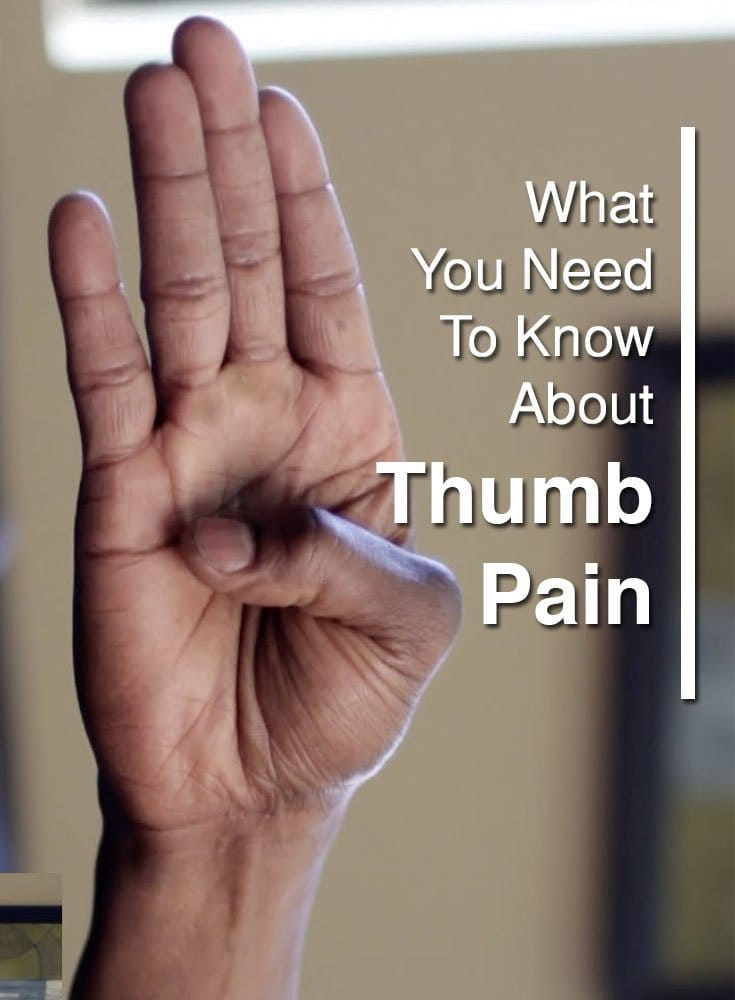The thumb has one of the most flexible joints in the body, so it is prone to overuse. Making matters worse, so many of our daily activities, from getting dressed to eating breakfast to typing at the keyboard, involve our hands. So, the overuse potential is even higher.
Now for the medical stuff, which is important to know if your severe thumb pain needs medical attention. The thumb joint is called the carpometacarpal joint. Basically, this is the area where the metacarpal bone moves with the wrist’s trapezium bone. All that movement means lots of cartilage, muscles, and ligaments.
So, there are a lot of things that can go wrong. Fortunately, in many cases, it’s not too hard to repair the damage.
Thumb Pain Causes
Most thumb pain either comes from trauma injury or overuse over time. We usually refer to sprained ligaments as a “jammed” thumb. Injuries like these cause sudden pain and loss of motion. In extreme cases or if you do not take steps to address the injury, the sprained ligaments can permanently damage the joint.
Just as it is with any other joint, thumb overuse often leads to osteoarthritis, which just means that the cartilage wears down. Osteoarthritis is not curable but it is treatable. Some contributing factors include:
-
Excessive Activity: Admittedly, this category is very vague, because what is “excessive” for one person may be normal for someone else. As a rule of thumb (pardon the pun), if you feel any discomfort in this joint, try to reduce use, perhaps by learning to be ambidextrous when dressing.
-
Rheumatoid Arthritis: RA is an autoimmune disorder in which the body’s immune system attacks its own tissues, causing joint inflammation. This condition, like osteoarthritis, is treatable although not curable.
-
Carpal Tunnel Syndrome: Nerve compression causes CTS and symptoms like pain, numbness, and tingling. Eventually, if left untreated, the nerve compression will most likely cause the muscles to atrophy.
If discomfort moves from the level of a mild, dull ache to pain while gripping or grasping, your thumb probably has an overuse injury.
Treating Thumb Pain
A conservative treatment approach nearly always works best in these cases. Trauma injuries usually take between six and eight weeks to heal. Obviously, if the issue is overuse or other chronic injury, the thumb will never “heal,” but it will get much better.
-
Reduce Inflammation: Inflamed tissues cannot move as well and they hurt badly, so this step addresses two issues simultaneously. Ice is a good way to reduce inflammation; for the thumb, massaging an ice cube over the area until it feels numb is usually a good idea. Also, many topical ointments and creams work well.
-
Immobilization: Injured thumbs, as opposed to diseased ones, should be kept still to avoid aggravating the injuries. Just select the thumb brace that’s best for you. Try a bigger brace that prevents any use whatsoever for the first few weeks, then move to a smaller brace that severely restricts movement for the last few weeks.
-
Physical Therapy: You basically have a choice between home exercises and a certified CHT therapist. Thumb exercises gradually increase mobility, while a therapist will probably use more advanced techniques, such as ultrasound, ice therapy, and iontophoresis.
-
Exercise: Whereas texting, typing, and so on may only further damage the joint, these exercises can help rebuild it.
The most effective treatment approaches combine a little of each of these elements.
In the event that these non-invasive procedures either do not work at all or fail to produce the desired results, you may want to consider injections or surgery. A doctor can inject corticosteroids that should decrease pain and add mobility to the joint; most people can get two or three injections a year. Surgery is a last resort, and possible procedures include trapeziectomy (removing one of the wrist bones) and joint fusion. Both these procedures will end the pain but limit mobility.
The stakes may be higher than you think, because for example, less than a quarter of CTS patients can return to their previous professions, even after surgery. So, when you experience thumb pain, it’s very important to understand it and proactively deal with it, so you do not become a statistic.



